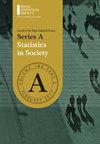Biostatistics Decoded
IF 1.6
3区 数学
Q2 SOCIAL SCIENCES, MATHEMATICAL METHODS
Journal of the Royal Statistical Society Series A-Statistics in Society
Pub Date : 2023-08-08
DOI:10.1093/jrsssa/qnad093
引用次数: 6
Abstract
Description: Study design and statistical methodology are two important concerns for the clinical researcher. This book sets out to address both issues in a clear and concise manner. The presentation of statistical theory starts from basic concepts, such as the properties of means and variances, the properties of the Normal distribution and the Central Limit Theorem and leads to more advanced topics such as maximum likelihood estimation, inverse variance and stepwise regression as well as, time–to–event, and event–count methods. Furthermore, this book explores sampling methods, study design and statistical methods and is organized according to the areas of application of each of the statistical methods and the corresponding study designs. Illustrations, working examples, computer simulations and geometrical approaches, rather than mathematical expressions and formulae, are used throughout the book to explain every statistical method. Biostatisticians and researchers in the medical and pharmaceutical industry who need guidance on the design and analyis of medical research will find this book useful as well as graduate students of statistics and mathematics with an interest in biostatistics Biostatistics Decoded:-Provides clear explanations of key statistical concepts with a firm emphasis on practical aspects of design and analysis of medical research.-Features worked examples to illustrate each statistical method using computer simulations and geometrical approaches, rather than mathematical expressions and formulae.-Explores the main types of clinical research studies, such as, descriptive, analytical and experimental studies.-Addresses advanced modeling techniques such as interaction analysis and encoding by reference and polynomial regression.生物统计学解码
研究设计和统计方法是临床研究者关注的两个重要问题。本书旨在以一种清晰而简洁的方式解决这两个问题。统计理论的介绍从基本概念开始,如均值和方差的性质,正态分布的性质和中心极限定理,并导致更高级的主题,如最大似然估计,逆方差和逐步回归,以及时间到事件和事件计数方法。此外,这本书探讨了抽样方法,研究设计和统计方法,并根据每个统计方法和相应的研究设计的应用领域组织。插图,工作实例,计算机模拟和几何方法,而不是数学表达式和公式,在整个书中用来解释每一个统计方法。生物统计学家和研究人员在医疗和制药行业谁需要指导医学研究的设计和分析会发现这本书有用,以及研究生统计和数学与生物统计学的兴趣生物统计学解码:-提供了明确的解释关键统计概念与设计和分析医学研究的实际方面的坚定强调。-使用计算机模拟和几何方法,而不是数学表达式和公式来说明每种统计方法的工作实例。-探讨临床研究的主要类型,如描述性研究、分析性研究和实验性研究。-地址先进的建模技术,如交互分析和编码的参考和多项式回归。
本文章由计算机程序翻译,如有差异,请以英文原文为准。
求助全文
约1分钟内获得全文
求助全文
来源期刊
CiteScore
2.90
自引率
5.00%
发文量
136
审稿时长
>12 weeks
期刊介绍:
Series A (Statistics in Society) publishes high quality papers that demonstrate how statistical thinking, design and analyses play a vital role in all walks of life and benefit society in general. There is no restriction on subject-matter: any interesting, topical and revelatory applications of statistics are welcome. For example, important applications of statistical and related data science methodology in medicine, business and commerce, industry, economics and finance, education and teaching, physical and biomedical sciences, the environment, the law, government and politics, demography, psychology, sociology and sport all fall within the journal''s remit. The journal is therefore aimed at a wide statistical audience and at professional statisticians in particular. Its emphasis is on well-written and clearly reasoned quantitative approaches to problems in the real world rather than the exposition of technical detail. Thus, although the methodological basis of papers must be sound and adequately explained, methodology per se should not be the main focus of a Series A paper. Of particular interest are papers on topical or contentious statistical issues, papers which give reviews or exposés of current statistical concerns and papers which demonstrate how appropriate statistical thinking has contributed to our understanding of important substantive questions. Historical, professional and biographical contributions are also welcome, as are discussions of methods of data collection and of ethical issues, provided that all such papers have substantial statistical relevance.

 求助内容:
求助内容: 应助结果提醒方式:
应助结果提醒方式:


